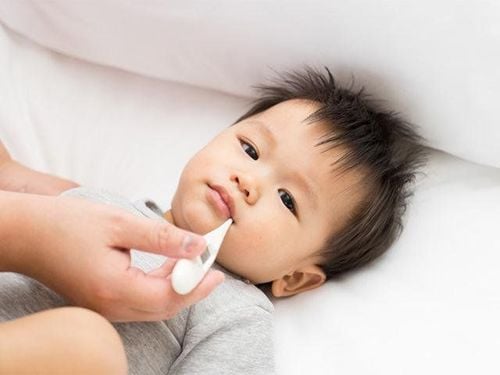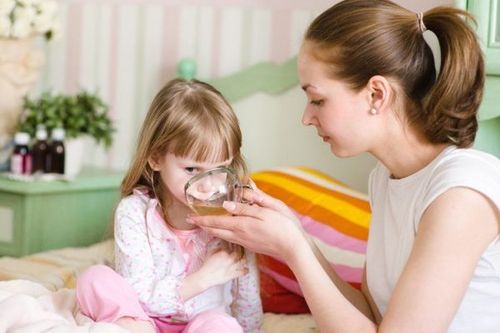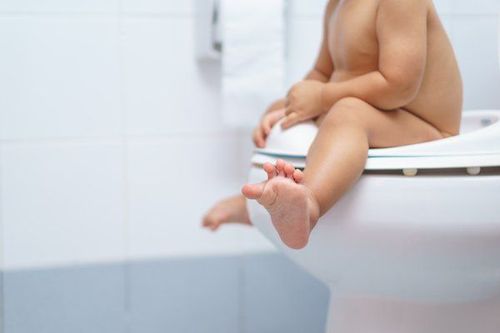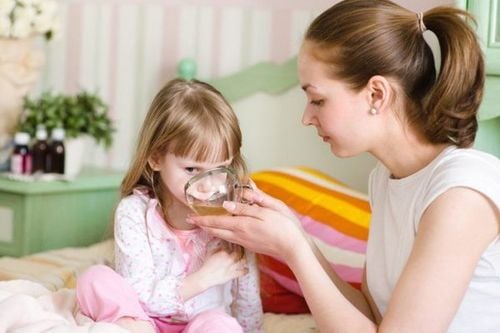This is an automatically translated article.
The article was written by Pediatrician Nguyen Phuong Hoa Binh - Vinmec Saigon International Clinic1. Body temperature when a child has a fever Normally, most people's body temperature is unstable and fluctuates slightly during the day: Slightly lower in the morning and higher in the evening. Body temperature changes when children run, jump, play, or exercise. Fever is a condition in which the body temperature is 1°C higher than the normal body temperature. Specifically, in case of fever, the temperature is > 38°C when measured rectally or orally, > 37.5°C when measured in the armpit. It is very common for children to have a fever, but not all fevers are dangerous, serious illnesses. Sometimes that's a good sign, when it's the body's way of fighting an infection.
Fever is not a disease but a symptom of many causes but mostly infections (germs, viruses, parasites). There may also be fever due to malignancy, systemic disease or drug fever, post-vaccination, teething, or unknown cause. The temperature when fever is high or low does not depend on how severe or mild the illness is. Sometimes the fever is high, but it's not too serious. In contrast, there are children who do not have a fever, or even have abnormal hypothermia (especially infants) with potentially serious illness. High fever when the temperature is ≥ 39°C. When fever > 41°C, the body is at risk of convulsions and brain damage. Fever is often accompanied by a few other signs, but sometimes it is just a fever.

2. Treatment when the child has a fever When the child has a fever, mothers should not worry too much, can self-treat the child by:
Wipe cool and take fever-reducing medicine. Drink more water of all kinds, for babies under 6 months who are exclusively breastfed, increase the amount of suckling because breast milk already contains water. Wear light, airy clothing. Stay in a well-ventilated, well-ventilated room without closing the door. How to cool off
When a child has a mild fever or a high fever combined with fever-reducing medicine, they can cool off. Cooling is very effective if done correctly. It is not necessary to use cool or cold water to wipe the baby, but use warm water.
Method 1: Wipe with a towel. Mix warm water like bath water in a basin, soak 5 towels in water, squeeze gently (do not squeeze out all the water) to put 4 towels in 2 underarms and 2 groins, 1 towel to wipe the whole body. Move and change the towel soaked in water continuously until the temperature drops. Note do not use this method when in a cold environment. Because cold makes the water in the towel cool very quickly, it will make the baby uncomfortable and cold water will constrict blood vessels, causing heat retention in the body.
Method 2: A warm bath is the better way. Have a child with a fever sit in a basin of warm water and splash warm water all over the body (including the head). After 5-7 minutes, dry immediately and wear light, airy clothes. At the same time, it is necessary to observe and monitor the child to see if there are any other accompanying symptoms?
Need to observe a child with a fever:
Is the spirit playful and playful? How to eat, drink, vomit? Is there a cough, rapid breathing, difficulty breathing, irregular breathing? Does fever reduce when taking antipyretics? Is there pain or any other unusual signs? It is possible to monitor and reduce fever at home if the child is still fresh, plays well, has a rosy skin tone, eats normally, has no fever within 2 days and has no other signs. How to use antipyretic:
When the child has a moderate or high fever and when the cooling is not effective: Give the child a medicine containing paracetamol at a dose of 10-15mg/kg body weight/time. Every 4-6 hours / 1 time if fever is still present. In cases where the child cannot drink such as sleeping or vomiting, the tablet can be inserted into the anus with the dosage as above.

High fever is difficult to bring down. Fever for more than 2 days Infants ≤ 2 months of age Any unusual signs. Parents can take their children to Vinmec International General Hospital for examination and treatment. The pediatric department at Vinmec International General Hospital is the address for receiving and examining diseases that infants and young children are susceptible to: viral fever, bacterial fever, otitis media, pneumonia in children ,....With modern equipment, sterile space, minimizing the impact as well as the risk of disease spread. Along with that is the dedication from the doctors with professional experience with pediatric patients, making the examination no longer a concern of the parents.
If there is a need for consultation and examination with experienced pediatricians at Vinmec. Please make an appointment at the website to be served.
Please dial HOTLINE for more information or register for an appointment HERE. Download MyVinmec app to make appointments faster and to manage your bookings easily.













